Pulsating air-breathing engines from Wave Engine (USA)
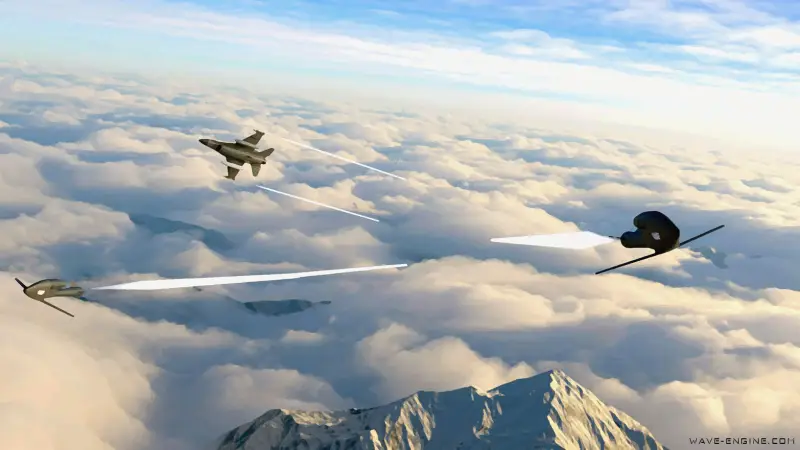
The promising VALP platform as imagined by an artist
Aircraft-type unmanned aerial vehicles can be equipped with propulsion systems of different classes. In particular, the American company North American Wave Engine Corporation proposes the use of pulsed air-breathing engines (PvRE) and is developing similar devices. Previously, it has repeatedly demonstrated its engines on a stand and on aircraft. The company is currently testing an experimental Scitor-D UAV equipped with a J-1 engine.
Development process
The North American Wave Engine Corporation (abbreviated as Wave Engine Corp.) was founded in Baltimore (Maryland) in the first half of the 1900s by former employees of leading US enterprises in the field of engine building. From the very beginning, the company's goal was to develop pulsed air-breathing engines with different characteristics suitable for use on various aircraft.
In 2016, Wave Engine Corp. began bench testing of the first PuVRD of its own design. The first real results of the project allowed us to count on support from potential customers. Thus, in 2019, the company received $2,85 million from DARPA to continue work. Later, the company received other grants of one size or another.
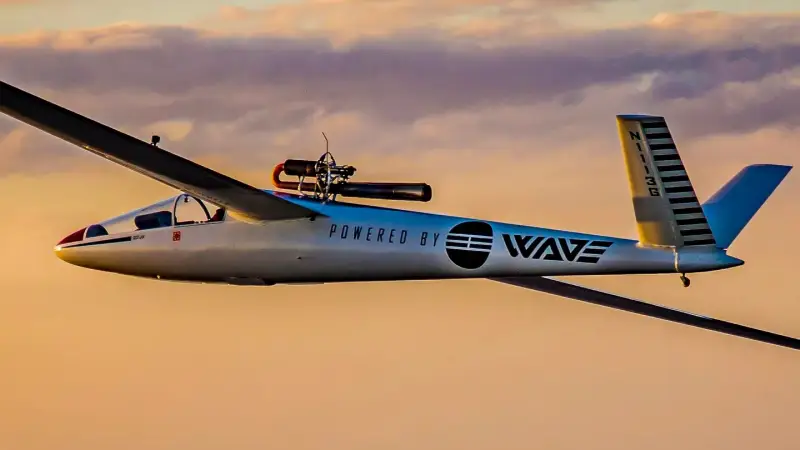
Experimental glider with PURD, 2020
The following year, an experimental engine - probably with money from the Pentagon - was brought to flight testing. A serial non-motorized glider was used as an air platform for the experimental PuVRD. Installing the engine significantly improved its flight performance and flight duration. In addition, such tests showed the potential of the aircraft using optimized aerodynamics and a pulsating engine.
In June 2021, the US Air Force Weapons Command awarded Wave Engine an order to develop the Versatile Air-Launched Platform (VALP). The contract value was $1 million; the timing of its implementation was not specified. It was reported that the goal of the project is to create a small-sized UAV with a thruster capable of carrying a small payload. In particular, the possibility of using it as a decoy to deceive enemy air defenses was considered.
By the time the contract for VALP was received, the development company had managed to formulate the general appearance of such a product and even published an artistic demonstration of its use. Subsequently, work on the project continued, but its results remain unknown. The finished UAV, similar to the 2021 pictures, has not yet been shown.
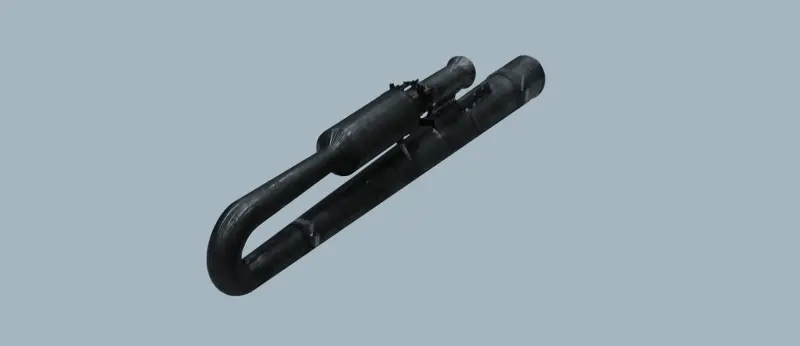
Engine type J-1
Results achieved
Despite the presence of an order for the development of a multi-purpose UAV, Wave Engine's main area of activity remains the creation of pulsed air-breathing engines. To date, two such products have been developed with different characteristics, ready for use on aircraft of different weight categories. In addition, the appearance of new PuVRDs has been announced.
The company offers customers two engines. The first is designated J-1 and is intended for aircraft with a take-off weight of no more than 200 pounds (90,8 kg). It produces up to 55 lbs (25 kgf) of thrust. A similar K-1 engine has also been developed, characterized by increased dimensions and a thrust of 220 pounds (approx. 100 kgf). They are offered to equip aerial platforms weighing up to 1000 pounds (454 kg). It is assumed that the following samples of this family will surpass the K-1 product in their parameters.
Wave Engine ramjet engines are built using a valveless design, which simplifies the design and provides a long service life. The engine is made in the form of a U-shaped pipe of variable diameter. The upper part of such a device has a smaller diameter, but carries a cylindrical combustion chamber of increased cross-section. The lower pipe is made conical and has a larger diameter. The ends of the pipe serve as nozzles. An electronic control system has been developed specifically for the new series of engines, controlling fuel supply and overall operation.

Product K-1
The operating principle of such engines is quite simple. A portion of fuel is injected into the combustion chamber and ignition is performed. Combustion products flow through both pipe-nozzles directed towards the tail of the aircraft and create thrust. At the same time, at a certain point in time, the thrust in the lower pipe of a larger diameter exceeds the thrust in the upper one, and the latter begins to draw atmospheric air into the combustion chamber. Then a new fuel injection is made and the cycle repeats. Due to the absence of constant combustion and the use of successive flashes, such a VRD is called pulsating.
Experienced drone
For flight testing of the J-1 engine with 25 kgf thrust, Wave Engine developed an original unmanned aerial vehicle called Scitor-D. In early March, the company announced the start of its flight tests and published a video of the first flight. The tests will continue and will ensure testing of the design of the UAV and the PURD, as well as their interaction.
The Scitor-D UAV is built according to a normal aerodynamic design. It has an elongated fuselage of variable cross-section with internal compartments for payload, equipment and liquid fuel. The pulsating engine is placed above the fuselage using holding devices. A slightly swept wing is used, equipped with protruding fairings of the main landing gear. The tail unit is made in an H-shape and does not interfere with engine operation.
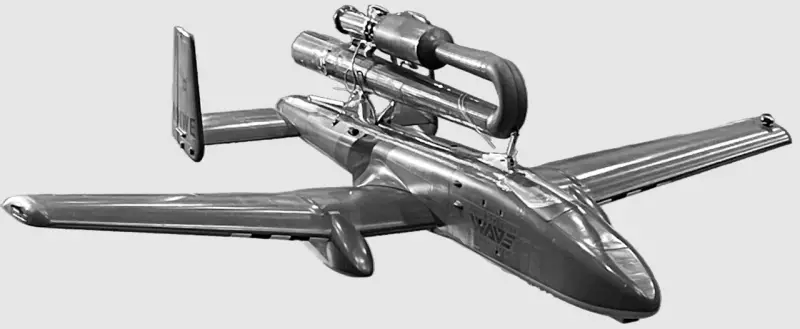
General view of the Scitor-D UAV
Takeoff weight drone determined by the parameters of the J-1 engine and is 100 lbs. A payload of 20 pounds (approx. 9 kg) can be carried on board. The dimensions of the product are not specified. The video shown suggests that the wingspan of the UAV reaches 3-3,5 m. The maximum flight speed is stated at 200 knots (370 km/h). The flight range and duration achieved by the unusual propulsion system are unknown.
At the moment, the experimental Scitor-D UAV carries a simplified set of on-board equipment. It ensures the reception and execution of operator commands, as well as the collection and transmission of data. In the course of further development, the drone may receive additional devices to solve practical problems. Due to its limited carrying capacity, the drone will only be able to carry optical or electronic reconnaissance equipment. Application weapons does not seem possible.
However, the main task of the Scitor-D product at the moment is not to conduct reconnaissance or perform other real tasks, but to demonstrate the capabilities of the PURD. With this development, Wave Engine wants to show the potential of such engines in general, as well as determine their real capabilities in the field of unmanned aviation. In essence, we are talking about an experiment and a kind of advertising of future developments in this area.
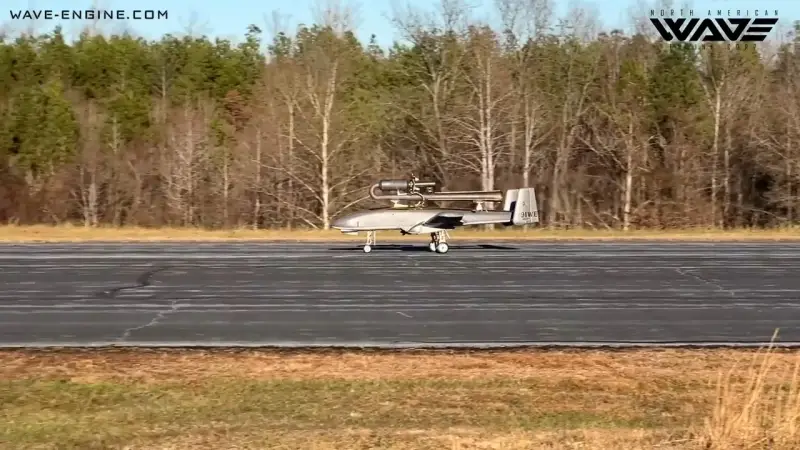
Scitor-D takes off
Characteristic Benefits
The valveless ramjet design being developed by Wave Engine has its own characteristic features that determine the achievable level of technical parameters and the potential in general. At the same time, a pulsating engine of such an architecture can compare favorably with power plants of other classes and types - and be of interest from the point of view of specific projects.
Like other jet engines, the PuVRD uses fuel energy quite efficiently, due to which it can develop high thrust. Thanks to this, the PURD allows higher speeds than an internal combustion engine with a propeller or an electric motor. In terms of thrust indicators and achieved flight performance characteristics, the PuVRD is close to turbojet engines. At the same time, its design is much simpler. There are no moving parts, the manufacture of which is a separate technological problem.
Thus, PURD can find application in those areas where sufficiently high thrust and flight characteristics are required, but at the same time it is necessary to simplify and reduce the cost of the design. North American Wave Engine Corporation believes that such engines should be implemented in the field of light and medium-sized UAVs. In addition, the company is clearly demonstrating the potential of this idea with a new prototype drone.
The experimental Scitor-D UAV is currently being tested and is helping to test the design of the J-1 product. It will also help the development of other engines of the promising line and the creation of new UAVs with PURD. In particular, it cannot be ruled out that the current pilot project is directly related to the previously launched VALP program and will contribute to the emergence of this multi-purpose platform. It is unknown when and how all this work will be completed, but the development company is optimistic and intends to continue its projects.
Information